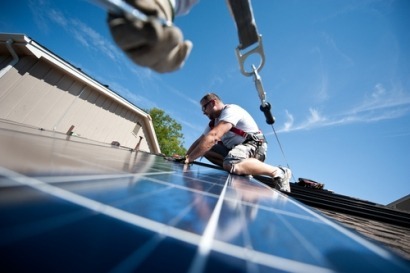
The figures have revealed that the average combined savings and income made from households installing solar PV panels has increased by nearly £100.Previous data prior to 1st November this year indicated that the average combined savings and income for households installing solar PV panels was around £540 per year; however, new figures show this has increased to £635.
The Energy Saving Trust, who assessed the data, indicate that the main reason for this increase in income and savings is due to the average size of the solar PV installations increasing, even though the Feed-in Tariff rate has dropped.
“The average size of solar PV installations has increased from 3kWp to 3.5kWP, which basically means households are generating more electricity and therefore more savings and Feed-in Tariff income” said Ian Cuthbert, EST renewables expert. “It is clear that UK households are increasingly looking to get the maximum yield for their roof to maximise the benefits of the solar installation.”
The updated solar figures have been published alongside new survey findings from the Trust which shows a third of people in the UK have been approached with solar panels in the past year but only four per cent chose to purchase them.
“We hope the latest data and figures will provide householders, whose homes are appropriate for solar panels, with the reassurance that they will be making significant savings and income as a result of the installation” Cuthbert added. “These savings could be even higher if householders take steps to reduce the amount they export to the grid by shifting some of their electrical demand to during the day when the solar PV system is generating. For example, using the washing machine during the day instead of at night. It is also important for installers to be offering the right measure in the right home alongside the right advice to ensure that trust continues to be built between them and householders who could benefit from solar installations.”
The Trust worked out the annual generation, income and savings through their Solar Energy Calculator building in to the calculations various factors including the generation tariff of 15.44p/kWh and export tariff of 4.5p/kWh and a home with a roof tilt of 40 degrees and roof orientation precisely south facing thereby finding that a home with a 3.5kWp system would generate around 3000kWh. The Trust also assumed an average installation price of £7,600 including VAT for a 3.5kWp system.
This figure is the average contract value for the period June – September 2012 though householders may end up paying significantly less at time of this press release as costs continue to fall. The figures also assume 75% export of energy and 25% onsite savings and the possession of an Energy Performance Certificate (EPC) of band D or higher
When looking to install solar panels, the Energy Saving Trust recommends the use of a Solar Energy Calculator to find out how much you could save and earn through solar panel installations. The Feed-in Tariff rate will depend on both your eligibility date and your property’s Energy Performance Certificate (EPC) band. Band D or higher will receive the higher rate of FITs. Band E or lower will receive the lower rate.
Ensure that you only install MCS-certified products and only sign a contract with an MCS-certified installer that is also a member of the REAL Consumer Code. It is also a very good idea to obtain at least three quotes before signing a contract.
Further information:

